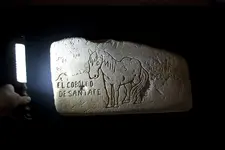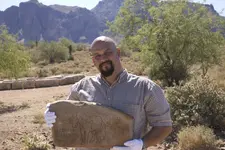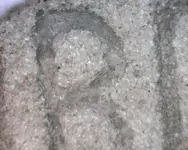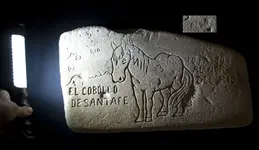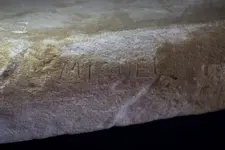First, as I have stated from day one, that since there is no provenance on the Stone Maps (100%) before 1949, to be intellectually honest with myself and everybody else, I cannot discount the possibility of them being modern carvings. Anybody that says they know 100% whether the Stone Maps are modern or hundreds of years old is full of **it. Between Larry, Garry, and myself, we pretty much have the entire history of the Stone Maps from 1949 onward settled. To judge on what came before, I can only go by the actions of the owners and my personal character judgement based on those actions.
There are three possibilities of how Travis Tumlinson came by the Stone Maps:
1. He found them just like he said he did. Just North of the 60 at Florence Junction.
The story he told his wife and his Uncle Robert was that he found the Stone Maps when he was trying to get a good view of Weaver's Needle for a picture . He even drew a map for his Uncle Robert showing exactly where he found them. He took a picture of three of the stones on his bumper right after he found them. After that picture was taken, he took the stones to the house of his friend in Apache Junction Charlie Miller. Miller later told another AJ Local Al Reser, that when Tumlinson brought the stones to his house, he helped clean them. He said that there were still little roots growing inside the grooves. Al Reser later went to the spot where Tumlinson said he found the stones and claimed to have found The Latin Heart as well.
2. His Grandfather John "Pegleg" Tumlinson (a well known treasure hunter around the turn of the century) got them from a person that stole them from the Mission at Arizpe, Mexico.
If this is true, then it means the Latin Heart was not real, but this possibility answers a lot of questions regarding why the maps were put on stone. The story goes that in the last few years before their suppression, the Jesuits hid all their wealth in the New World. I believe that each rectorate was responsible for hiding its own wealth, which is why we have so many Jesuit Treasure Stories from so many different places. I think that one of the larger hiding places was in the far Northern Reach of the Jesuits of 1765-6; The Superstitions. The Jesuits had already been arrested, kicked out of, and suppressed by first the Portuguese (1759) and the French (1764). It was only a matter of time before the Spanish followed suit. When the Jesuits were arrested, they were ONLY allowed to keep the clothes on their backs, their Breviaries, and a copy of Sir Thomas A Kempis' Book "An Imitation of Christ". The Spanish knew how much wealth the Jesuits had. The day of their Spanish Suppression (26 June 1767), when the Spaniards rushed into all the Jesuit Colegios and Missions, they tore the places up looking for hidden treasure. If any of the Jesuits had been carrying any maps, they would most definitely have been found. The Jesuits knew what was coming, but they didn't know how long it might be before they could get back to the New World to recover their wealth. Maps on parchment or vellum are subject to be easily destroyed. Chewed by rats. Destroyed by floods or fires. It might have been 200 years before the Jesuits could reclaim their treasure. They needed maps that could last that long. Stone Maps would last forever, but where to put them so a Jesuit 200 years later could easily find them and get the wealth back to the Church/Order? Well, locally important people are entombed inside Churches all over the world. Pimeria Alta was no exception. Inside every church, are many prominent locals' tombs. I think the Stone Maps were hidden by covering the tomb of a prominent local from Arizpe. That is why there is a Cross on the back of one and the word "DON" on the back of another. A Spaniard even looking for hidden treasure would not disturb the tomb of a dead man. The Stone Maps stayed safe there until they repaved the floor of the Church/Mission in the late 1800s. The maps were found, and they made their way to a famous Texas Treasure Hunter (Pegleg Tumlinson).
3. He made them
I put #3 at a very distant third place because of what Travis did with the Stone Maps while he owned them. His actions are in NO WAY indicative of someone who hoaxed the Stone Maps for profit or fame. To make a long story short, in the twelve (12) years that he owned the Stone Maps, he never attempted to sell them. In the twelve (12) years that he owned the Stone Maps, he mostly kept their existence a secret. He never attempted to get his name in any magazines or newspapers. He only showed them to a very few people that he knew well. His daughter Janie told me in no uncertain terms that her dad in no way hoaxed the Stone Maps.
Hal,
Any metal carving tool (old or new) would have left little traces (if the stones hadn't been cleaned many times). I was hoping to find some traces of metal, because we could tentatively date the stones by the makeup of the metal used to carve them. We could easily tell the difference between a tiny chip of modern carbon steel versus a chip of 18th century softer steel.
1. Any type of metal tool. The Stone Maps have been cleaned so many times since they were found (supposedly) in 1949, that there is a good chance any of the original material used to carve them is long washed away.
2. Any type of metal is harder than any of the stones.
3. I think the stones were ground smooth. The maps were drawn on them. Something small was used to start the groove by scratching along the lines. Then, something bigger was used to open the grooves up some. I use the term scratching rather than carving or engraving because it looks like a tool was placed on the surface. Pressure was put on it, and it was dragged toward the engraver in a scratching motion. Someone carefully using a Dremel would not carve a line by jumping out of the groove:
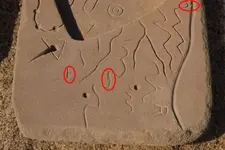
I can't tell you why exactly Father Polzer SJ said they were fakes. Maybe Chlsbrns has more info on that. I can only say that ANYTHING he was ever shown that supposedly came from Jesuit wealth, he said was a fake. I know several people that personally knew the man that say he was a great person. He just was a Jesuit Wealth Denier. My guess is that since he publicly stated in no uncertain terms that there are no Jesuit Treasures, then anything that pointed that way had to be fake.
Also, if you spend a lot of time looking at the Stones, it looks like there are two sets of carvings on them. One set deeply grooved, and another set of shallower carvings. Tumlinson told a friend of his that he had added carvings to the Stones so it would throw off anybody that might steal them from him. He never gave any details about what carvings he added, unfortunately.
See what looks like two different sets of carvings:
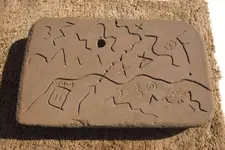
The math equation is shallow and the map parts are deeper and look older.
Mike




